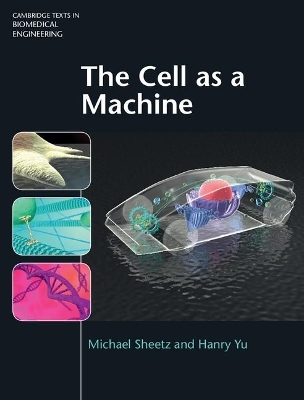
The Cell as a Machine
Cambridge University Press (Verlag)
978-1-107-05273-4 (ISBN)
This unique introductory text explains cell functions using the engineering principles of robust devices. Adopting a process-based approach to understanding cell and tissue biology, it describes the molecular and mechanical features that enable the cell to be robust in operating its various components, and explores the ways in which molecular modules respond to environmental signals to execute complex functions. The design and operation of a variety of complex functions are covered, including engineering lipid bilayers to provide fluid boundaries and mechanical controls, adjusting cell shape and forces with dynamic filament networks, and DNA packaging for information retrieval and propagation. Numerous problems, case studies and application examples help readers connect theory with practice, and solutions for instructors and videos of lectures accompany the book online. Assuming only basic mathematical knowledge, this is an invaluable resource for graduate and senior undergraduate students taking single-semester courses in cell mechanics, biophysics and cell biology.
Michael Sheetz is Chair of Biological Science at Columbia University, Founding Chair of the Department of Cell Biology at Duke University, and Founding Director of the Mechanobiology Institute at the National University of Singapore. He is also a recipient of the Albert Lasker Basic Medical Research Award. Hanry Yu is a Professor in both the Department of Physiology and the Mechanobiology Institute at the National University of Singapore, and a Group Leader at the Agency for Science, Technology and Research, Singapore. He has co-taught the material in this book with Michael Sheetz at Massachusetts Institute of Technology, Columbia University, and the National University of Singapore.
Part I. Principle of Complex Function in Robust Machines: 1. Robust self-replicating machines shaped by evolution; 2. Complex functions of robust machines with emergent properties; 3. Integrated complex functions with dynamic feedback; 4. Cells exhibit multiple states, each with different functions; 5. Life at low Reynolds number and the mesoscale leads to stochastic phenomena; Part II. Design and Operation of Complex Functions: 6. Engineering lipid bilayers to provide fluid boundaries and mechanical controls; 7. Membrane trafficking – flow and barriers create asymmetries; 8. Signaling and cell volume control through ion transport and volume regulators; 9. Structuring a cell by cytoskeletal filaments; 10. Moving and maintaining functional assemblies with motors; 11. Microenvironment controls life, death and regeneration; 12. Adjusting cell shape and forces with dynamic filament networks; 13. DNA packaging for information retrieval and propagation; 14. Transcribing the right information and packaging for delivery; 15. Turning RNA into functional proteins and removing unwanted proteins; Part III. Coordination of Complex Functions: 16. How to approach a coordinated function – cell rigidity sensing and force generation across length scale; 17. Integration of cellular functions for decision making; 18. Moving from omnipotency to death; 19. Cancer versus regeneration – the wrong versus right response to the microenvironment.
| Erscheinungsdatum | 10.02.2018 |
|---|---|
| Reihe/Serie | Cambridge Texts in Biomedical Engineering |
| Zusatzinfo | 1 Halftones, black and white; 136 Line drawings, color; 1 Line drawings, black and white |
| Verlagsort | Cambridge |
| Sprache | englisch |
| Maße | 192 x 253 mm |
| Gewicht | 1110 g |
| Themenwelt | Medizin / Pharmazie ► Physiotherapie / Ergotherapie ► Orthopädie |
| Studium ► 1. Studienabschnitt (Vorklinik) ► Physiologie | |
| Technik ► Medizintechnik | |
| ISBN-10 | 1-107-05273-4 / 1107052734 |
| ISBN-13 | 978-1-107-05273-4 / 9781107052734 |
| Zustand | Neuware |
| Haben Sie eine Frage zum Produkt? |
aus dem Bereich


